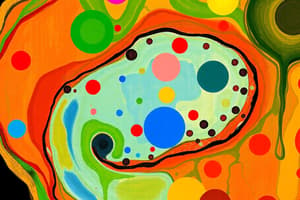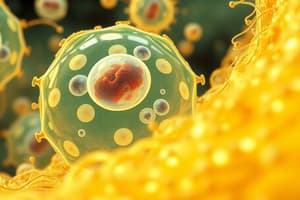Podcast
Questions and Answers
What is the main function of the cell wall in plant cells?
What is the main function of the cell wall in plant cells?
- Providing structural strength (correct)
- Supporting selective transport
- Regulating cellular processes
- Enabling movement within the cell
What is the role of the plasma membrane in a cell?
What is the role of the plasma membrane in a cell?
- Synthesizing proteins
- Storing genetic information
- Facilitating selective transport (correct)
- Providing structural strength
Which component is NOT found in the cell wall of plant cells?
Which component is NOT found in the cell wall of plant cells?
- Hemicellulose
- Lignin
- Peptidoglycan (correct)
- Pectins
Which type of cell lacks a true nucleus and has a cell wall made of peptidoglycan?
Which type of cell lacks a true nucleus and has a cell wall made of peptidoglycan?
According to the fluid mosaic model, how do integral membrane proteins behave in the plasma membrane?
According to the fluid mosaic model, how do integral membrane proteins behave in the plasma membrane?
Which of the following is a key characteristic of the phospholipid bilayer in the plasma membrane?
Which of the following is a key characteristic of the phospholipid bilayer in the plasma membrane?
Which organelle is responsible for energy production in the cell?
Which organelle is responsible for energy production in the cell?
What is the main function of the Golgi apparatus in a cell?
What is the main function of the Golgi apparatus in a cell?
Which cell component regulates what enters and exits the cell?
Which cell component regulates what enters and exits the cell?
What is the function of ribosomes in a cell?
What is the function of ribosomes in a cell?
Which type of cell component lacks defining boundaries but still performs essential tasks?
Which type of cell component lacks defining boundaries but still performs essential tasks?
What is the main function of the cytoplasm in a cell?
What is the main function of the cytoplasm in a cell?
Flashcards are hidden until you start studying
Study Notes
Cell Structure Overview
At the heart of biology lies the fundamental concept of cells, the building blocks of all living organisms. These tiny structures range from unicellular organisms like bacteria to multicellular entities like plants and animals. To comprehend the complexity of life, we must delve into the intricate architecture of cells and the various types of cell structure found throughout the domains of life.
Organelles and Membranes
Cells are organized around a central structure called the nucleus, housing the genetic material. Surrounding the nucleus are several specialized compartments known as organelles, each performing distinct roles in cell function. Some examples include mitochondria (energy production), chloroplasts (photosynthesis), lysosomes (degradation), endoplasmic reticulum (protein synthesis), and Golgi apparatus (post-translational modification).
The plasma membrane encases the entire cell, regulating what enters and exits while maintaining the internal environment constant. The cytoplasm fills the space between the plasma membrane and the nuclear envelope, containing the cell's molecules and organelles.
Cytoplasmic Inclusions
While organelles are semi-autonomous units surrounded by lipid bilayers, cytoplasmic inclusions lack defining boundaries and still perform essential tasks. Examples include ribosomes (translation of proteins), glycogen granules (storage of glucose), and lipid droplets (neutral fat storage).
Cell Wall and Cell Membrane
In contrast to animal cells, plant cells possess a rigid cell wall made of cellulose fibers embedded in a matrix of hemicellulos, pectins, and lignin. This wall provides structural strength and allows for rigidity, enabling plants to stand upright. Additionally, prokaryotic cells, like bacteria, lack a true nucleus and instead operate with a single circular chromosome within the cell. Their cell walls are composed of peptidoglycan, providing protection against osmotic pressure and mechanical forces.
Plasma Membrane Composition
The plasma membrane consists of a phospholipid bilayer intermingled with proteins, forming a hydrophobic barrier separating the inside of the cell from the outside environment. This arrangement ensures that polar molecules cannot pass through easily, allowing for selective transport.
Fluid Mosaic Model
The fluid mosaic model describes the plasma membrane as a dynamic entity where integral membrane proteins float freely within the lipid bilayer, being able to move laterally across the membrane surface.
Understanding cell structure helps us appreciate the diversity and complexity of life. From the smallest bacterium to the largest tree, cells serve as the foundation for our comprehension of biological processes and the development of medical treatments and technologies.
Studying That Suits You
Use AI to generate personalized quizzes and flashcards to suit your learning preferences.




